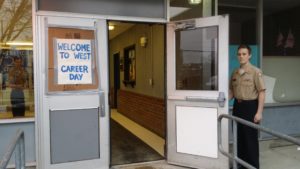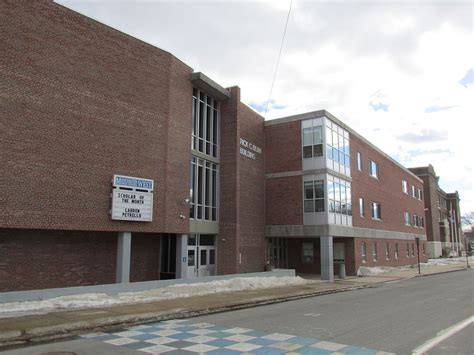
O’Connell: Maneuvering to close West
Is Central’s closure on the horizon?
The vice chairman of the Manchester Board of School Committee, at-Large Committee Member Jim O’Connell (D-Ward 2) paid an unannounced visit to Manchester West High Principal Rick Dichard to tell him the board plans to close the school. Sources familiar with the situation say O’Connell has the votes to close West.
Declining enrollment has dogged Manchester school officials for years. While enrollment has fallen across the district, it has plunged in the city’s three traditional high schools as tuition towns have withdrawn their students. Once home to approximately 2,300 students each, Central’s enrollment has fallen to approximately 1,300 students, Memorial’s to 1,400 and West’s to 750. A facilities study done for the district and made public in April, 2021 projected that high school enrollment will fall to 806 for Central, 930 for Memorial and 520 for West by 2030.
After receiving recommendations from then Superintendent Dr. John Goldhardt, the Board of School Committee set up community meetings to get feedback on the proposal and tasked then Assistant Superintendent Dr. Jenn Gillis with reformulating them based on community input. At the time, Gillis oversaw school facilities. Those recommendations are many months late but are expected to be brought forward this summer now that Gillis has been made superintendent.

Gillis: Slow-walking facilities recommendations
The district has been slow to respond to declining enrollments. Despite closing Hallsville Elementary School last year due to lack of enrollment, the district still has ample surplus space. A vote several years ago to redistrict the schools and move the 5th grade classes into the middle schools has been partially implemented with 5th grade being moved into Parkside and Southside but not Hillside, whose staff has actively opposed the measure since its adoption, or McLaughlin. Girard at Large has learned that O’Connell plans to reopen the discussion in an attempt to undo the redistricting to prevent the integration of fifth grade into the remaining middle schools and possibly unwind their integration at the other two schools.
O’Connell reportedly told Dichard that students from West will be moved to Central in the 2023-2024 school year and remain there until a new high school is built. Once completed, he said that the Central/West population will attend the new school, meaning Central will also be closed. Information gathered by Girard at-Large suggests that Memorial will remain open. Gillis, we are told, knew of O’Connell’s meeting with Dichard.
Some believe this is simply a ruse to lead West Side parents into believing their kids will eventually end up attending school in a new building to lessen their opposition to the proposal to close West, a school that’s been open for more than 100 years and is one of the most historic and storied high schools in New Hampshire. Their reasoning? “There’s no way the board will vote to close Central.” That was heard often and the firestorm caused by the suggestion it be closed nearly six years ago suggests it would be nearly impossible politically.

West’s doors to be locked for good?
If the board is looking to close schools to save money it is spending on empty space, then one would have to question why it would choose to close West instead of Central, even on a temporary basis. (A couple of questions that feed the skepticism over whether or not Central “is next:” If a new school is going to be built to combine the the two schools, why bother closing one of them “first?” Why not wait until it’s built to close them both?) The facilities study shows that repairs and renovations to Central would cost twice as much as those identified at West. What’s also clear is that ongoing maintenance and operations costs at Central far exceed those at West. (As a former four year member of both the Finance (2 years as chair) and Buildings and Sites committees, I can personally attest to this.)
Unlike Central, West’s sports fields are adjacent to the school, meaning student athletes don’t have to get on buses or otherwise have to travel to their practices or home games. The same goes for marching band practice. (Central currently uses Bronstein Park for marching band practice, which often has to be cleared of homeless vagrants and drug users and swept for used needles before practice. At West, if need be, field space at Parkside is just a few walkable blocks away.) West is one enclosed building and the “Quad,” an open space at the center of the school, is not accessible from the street, making West a much safer place for students generally than Central. There is adequate parking for students and staff across the street at West’s athletic complex. The poorly constructed and always leaking underground garage at Central isn’t capable of handling the current demand for parking so adding to that demand will further impose on neighboring residential areas. And, while we’re on the topic of surrounding neighborhoods, while the one around West isn’t ideal, it’s much quieter and safer than the neighborhoods surrounding Central. One of the reasons a second school resource officer was added to Central was to deal with people coming onto its campus from the surrounding neighborhood. Finally, Central would provide a much better redevelopment opportunity for the city if the school board closed it than would West, primarily because of location, but also because there are multiple buildings that can be addressed or used separately from the others.
In short, if facility efficiency is the goal of the board, then closing West is the wrong move, though a politically expedient one.
Publisher’s Note and Commentary: I want to go on record as not being in favor of closing any of the city’s high schools. The analysis of the information I’ve discovered is designed to address its merits and call into question the motives of Jim O’Connell and the others who, apparently, have been working behind the scenes to make this proposal a “done deal” once it’s brought forward. Whether or not Gillis brings it forward when her slow-walking of her facilities study recommendations finally comes to an end remains to be seen. That these decisions have already been made about the fate of the city’s poorest and most culturally diverse high school behind the public’s back is troubling and we bring it forward with our questions and skepticisms because you deserve to know.
As a candidate for mayor, I proposed a radically different way to operate the city’s schools. If the board wishes to continue to operate a command and control, centralized system that’s become more and more dictatorial, then deciding which schools stay open and which schools close makes sense. However, this approach does nothing to harness the talent of our educators, parents and community organizations; talent that could bolster the enrollment of successful programs and weed out the unsuccessful and make the decision to add or subtract space a function of the demands for it. The students, staff, parents and taxpayers deserve a chance to make things at their chosen school work before it’s taken away from them because they lack political clout. Click here to learn more. ~Richard H. Girard



